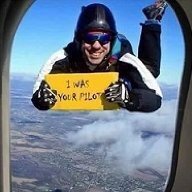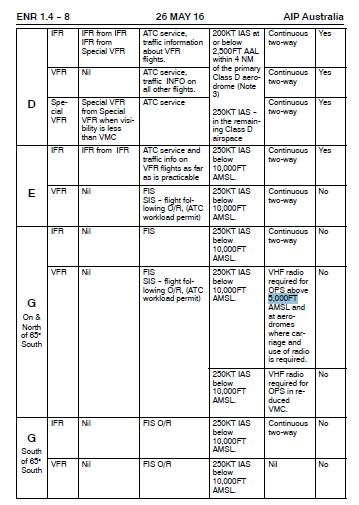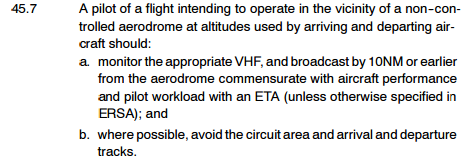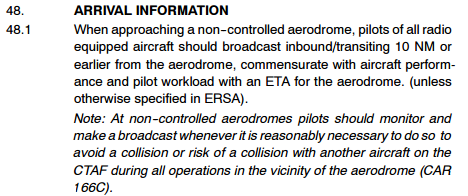-
Posts
1,532 -
Joined
-
Last visited
-
Days Won
15
Content Type
Profiles
Forums
Gallery
Downloads
Blogs
Events
Store
Aircraft
Resources
Tutorials
Articles
Classifieds
Movies
Books
Community Map
Quizzes
Posts posted by DrZoos
-
-
It is indeed, I had the foxbat absolutely nailed when I first learned, but now that Im used to a low wing, high wing loading Alpi, the Foxbat is a real handful. It blows around like a butterfly, which is ok, when you're flying it all the time. Partially caused by the fact my aircraft has to be one of the easiest aircraft in the world to land.With the yoke of course! I usually brake with the left hand. But sometimes taxing I'll use the right hand to brake while using my arm to hold in aileron if required. It is a little awkward but you get use to it. Flying the Skyfox gaxelle a while ago was weird having to use toe brakes .... I guess it just what you are use too.-
 1
1
-
-
Radio congestion in YPMQ CTAFR/T or traffic congestion? -
I had one main instructor, but due to some LAME exams, four instructors, all had their own strengths and weaknesses. But they all had a different set of tools in the toolbox. So what I lost in continuity, I gained in getting extra tools and perceptions.
I agree with camel, that having several instructors, especially once reasonably competent, can prove very beneficial. With a variety of instructors you get several viewpoints and a more diverse set of skills in your toolbox.
When I first had to change instructors, I found it very inconvenient and annoying. But in hindsight it was an outstanding move.
-
 1
1
-
-
I recently submitted a complaint to CASA about CTAF congestion. They responded within 24 hours, called me and are actively looking into it. Must say i was very impressed, so far.
-
So so many variables, dont read much into it.
-
The guys in the Coffs Tower are not very busy most the time, they are very helpful...simply use procedures as trained and they will be good. Or phone them up and ask.Hi all! Was due to have my first lesson flying in controlled airspace at Coffs harbour yesterday whilst on holiday but it got cancelled due to weather. Had a few questions I was going to ask the instructor so ill have to ask you guys instead:)i) Looking at the coffs harbour ERSA and VTC. How can you tell if the class D/Class C surrounding airspace has radar coverage or not?ii) Also, what sort of departure report would you give operating out of this airport? Would it be different if you were departing into Class C as opposed to class D or class G? At metro class D airports like camden no departure report is required so Im a little confused.
Thanks, Rich
-
Check out my tutorials on the course part of the website for CR4 they are basically the same .
How To Use CR4 Flight Computer – Pilot Practice Exams .com
Let me know if anything needs explaining further.
-
 2
2
-
 2
2
-
-
All of us following the same flawed protocols is far safer then everyone thinking they know better
-
 2
2
-
-
If there is no published Vb in the pilot operating handbook then its Va...maneuvering speed, generally 1.95 flaps up stall speed.
-
I did mine with multiple flights per week and took the minimum hours.... I think having them back to back is a huge advantage. But I also did a lot of rehearsing things on the ground... mental imagery...you can learn a hell of a lot about the procedural stuff without ever taking off. Eg your positional radio calls, your responses, all your checks. You can also rehears landing issues, as long as you have a clear visual picture of the issues and solutions.
Its 25 hours logged flight timeAs an update to this; got my pilot cert today. Around 32 hrs of flying, and it's taken 3 months at pretty much the fastest pace I could do - weekends nearly always booked (or hungover and can't fly...), then instructor off for 2 days, and to fit around work want early morning or late afternoon. Plane was serviced I think twice so that wiped out a week or so, thankfully only a handful of rainy days.All up approx:32 hrs of flying
32 hrs of driving (30 mins each way)
20 hrs of study. Probably 600 pages worth, so I still could re-read them another few times and still not remember it all
4 hrs of exams
So around 100 hrs over 3 months which is ~8 hrs a week. Certainly a bit more than the 25 hrs on the RAAus brochure...
-
 2
2
-
-
What humans discussing things, with all sorts of opinions, prejudices and presumptions...seems pretty normal behaviour to meUnbelievable!What you read on forums.-
 1
1
-
-
It was probably not reported.
-
 1
1
-
 1
1
-
-
He certainly taught me a lot, especially when I was looking to purchase and then after I purchased.
R.I.P. Ross
-
 1
1
-
-
Thats the only reference i can find other than in guides.
AIP GEN 2.2 definitions vicinity is 10nm
CAR 166
166 Operating in vicinity of a non-controlled aerodrome
(1) For this regulation and regulation 166A, an aircraft is in the vicinity
of a non-controlled aerodrome if it is within:
(a) airspace other than controlled airspace; and
(b) a horizontal distance of 10 miles from the aerodrome; and
© a height above the aerodrome reference point of the aerodrome
that could result in conflict with operations at the aerodrome.
-
 2
2
-
 1
1
-
-
Whiles there is no clear rule it is generally accepted:
If equipped with a radio:
Above 3000 feet use area
At or below 3000 on 126.7
In a CTAF you should be on CTAF
Note some busy scenic or agricultural areas may have a secondary multicom channels. See ERSA
From RAA website
Class G airspace
There are no mandatory reports for VFR aircraft operating enroute in Class G airspace, thus after departing the airfield vicinity such aircraft are only required to maintain a listening watch on the "appropriate frequency" and announce if in potential conflict with other aircraft – see AIP ENR 1.1 para 60.1.
So what's the 'appropriate' frequency?
The local Flight Information Area frequency, if so, calls would be directed to Flightwatch, see below. (Frequency information blocks depicting Class E and G frequencies and the frequency boundaries are included on the Frequency Planning Chart [see below] and on the VNC and VTC.)
or a listening watch could be maintained on other specific frequencies;
or the distress frequency 121.5 MHz;
or if below 3000 feet agl then listen out on 126.7;
or when passing near the vicinity of a non-controlled or a towered airport the designated [otherwise 126.7] frequency for that airfield should be monitored to gain information on local traffic.
From http://www.pilotpracticeexams.com/courses/lesson/which-frequency-to-use/
In the CTAF
Use CTAF frequency -Check ERSA FAC section
Outside CTAF
Use flight information area frequency (FIA) if above 3000 or Multicom 126.7 if below 3000 – check your charts
Be aware Class E above Class G, often operate on separate frequencies. Green frequencies on the charts will indicate Class G , brown will indicate Class E
Flight Information Services (FIS)
If you request flight following the ATC will help you avoid controlled airspace and advise you of traffic. You may be assigned a unique transponder code and radio frequency. It is advisable to lodge a flight plan if requesting flight following. See ERSA
From AIP 1.1
https://www.airservicesaustralia.com/aip/current/aip/enroute
-
 1
1
-
-
It has been a while, so hopefully i have all the relevant partsWhy do you say that a rotax prevents access to CTA?It's a lot of reading, but I believe you won't fit any of the categories of LSA, certified type and that Jab (the manufacturer) wont risk their neck and issue the required paperwork from a manufacturer, if you go and change the engine. I will paste the relevant parts her, I'm happy for and would actually love someone to prove me wrong.
I have discussed this at length when we were looking to do it... Most people's initial thought was it was ok, but once they read the relevant sections, everyone we spoke to said it would not comply.
Civil Aviation Amendment Order (No. R94) 2004 - Civil Aviation Order 101.55 - Airworthiness certification requirements - Aeroplanes with a maximum weight not exceding 450 kilograms (12/12/2004)SECTION 101.556.1 Engine Requirements. One of the following conditions must be satisfied in relation to the engine installed in the aeroplane: (a) the engine is of a type to which a certificate of type approval under this subsection applies; (b) the engine is of a type that has been certified as an aircraft engine in accordance with FAR 33, BCAR C or JAR E; © the engine is of a type that has been approved by CASA as being appropriate for use in aeroplanes to which this section applies. Note: An aeroplane to which this section applies that has an engine of a kind to which subparagraph 6.1 © applies may, because of the characteristics of that engine, have conditions included in its certificate of airworthiness.
Civil Aviation Order 95.55 Instrument 2011Civil Aviation Order 95.557.3 An aeroplane, to which this Order applies, may be flown in Class A, B, C or D airspace only if all of the following conditions are complied with:
(a) the aeroplane is:
(i) certificated to the design standards specified in Civil Aviation Order 101.55; or
(ii) meets the criteria specified in paragraph 21.024 (1) (a) or 21.026 (1) (a) or regulation 21.186 of CASR 1998 (see below); or
(iii) approved under regulation 262AP of CAR 1988 in relation to flights over closely-settled areas; (b) the aeroplane is fitted with an engine of a kind to which paragraph 6.1 of Civil Aviation Order 101.55 applies, or that CASA has approved as being suitable for use in an aircraft, to which this Order applies, and is not subject to any conditions that would prevent the flight; © the aeroplane is fitted with a radio capable of two-way communication with air traffic control; (d) the aeroplane is flown by the holder of a pilot licence with an aeroplane category rating: (i) issued under Part 61 of CASR 1998; and (ii) that allows the holder to fly inside the controlled airspace; (e) the pilot has a valid flight review for the class rating in accordance with Part 61 of CASR 1998; (f) the controlled airspace in which the aeroplane is operating requires a transponder to be fitted — the aeroplane is fitted with a transponder suitable for use in the airspace. Note Operations in Class A airspace in V.F.R. are only possible in accordance with a permission issued by CASA under regulation 99AA of CAR 1988.
7.1
(h) in the case of an aeroplane to which this Order applies by virtue of subparagraph 1.2 (b), ©, (f) or (g) — the aeroplane must not be flown over a closely-settled area at a height:
(i) from which it cannot glide clear of the closely-settled area to a suitable landing area; and (ii) that is lower than 1 000 feet above ground level;
1.2 For subparagraph 1.1 (e), an aeroplane must be 1 of the following:
(b) an aeroplane described in paragraph 1.1 of Order 101.55;
© an aeroplane described in paragraph 1.2 of Order 101.55 that meets the design standards in that Order;
(f) an aeroplane:
(i) of a type for which a type certificate, a certificate of type approval or an equivalent document has been issued by CASA, another national airworthiness authority (NAA) or a competent issuing authority; and
(ii) that has been manufactured for sale by the holder of a certificate, or an equivalent document, permitting the manufacture of aeroplanes of that type and issued by CASA or another NAA or a competent issuing authority; and
(iii) that has a maximum take-off weight not exceeding: (A) in the case of an aeroplane not equipped to land on water — 600 kg; or (B) in the case of an aeroplane equipped to land on water — 650 kg; and (iv) that has a payload that is equal to, or exceeds, the minimum useful load for that aeroplane determined in accordance with paragraph 1.3;
(g) a light sport aircraft:
(i) manufactured by a qualified manufacturer as defined by regulation 21.172 of CASR 1998; and
(ii) for which there is a current special certificate of airworthiness; Federal Register of Legislative Instruments F2015L00228 Civil Aviation Order 95.55 Page 3 of 10 pages
CIVIL AVIATION REGULATIONS 1988 - REG 262AP
Experimental aircraft--operating limitations
(4) A person must not operate an experimental aircraft over the built-up area of a city or town unless authorised to do so under subregulation (5).
Penalty: 50 penalty units.
(5) CASA or an authorised person may authorise a particular aircraft to be operated over the built-up area of a city or town subject to the conditions and limitations CASA or the authorised person considers necessary for the safety of other airspace users and persons on the ground or water.
(6) A person operating an experimental aircraft must operate it only:
(a) by day and under V.F.R; or
(b) otherwise in accordance with an approval by CASA or an authorised person.
CIVIL AVIATION REGULATIONS 1988 - REG 262AP Experimental aircraft--operating limitations
It also refers to 206, but thats just for banning commercial ops
CIVIL AVIATION REGULATIONS 1988 - REG 206 Commercial purposes (Act, s 27(9))
CIVIL AVIATION SAFETY REGULATIONS 1998 - REG 21.186 Special certificates of airworthiness for light sport aircraftCIVIL AVIATION SAFETY REGULATIONS 1998 - REG 21.186[/b]"]CIVIL AVIATION SAFETY REGULATIONS 1998 - REG 21.186Special certificates of airworthiness for light sport aircraft
(1) An applicant is entitled to a special certificate of airworthiness for a light sport aircraft if:
(a) the aircraft was manufactured by a qualified manufacturer; and
(b) the applicant gives CASA, or the authorised person referred to in regulation 21.176, the following:
(i) a statement of compliance by the manufacturer that complies with subregulation (2);
(ii) copies of the aircraft operating instructions, aircraft maintenance and inspection procedures, and aircraft flight training supplement, issued for the aircraft by the manufacturer;
(iii) in the case of a light sport aircraft manufactured outside Australia--written information showing that:
(A) the aircraft was manufactured in a Contracting State; and
(B) the aircraft is eligible for a certificate of airworthiness, or another document of similar effect, in the country of manufacture; and
© CASA or an authorised person finds, after inspection, that the aircraft is in a condition for safe operation.
(2) A statement of compliance must be signed by the manufacturer and include at least the following:
(a) a statement setting out the aircraft's make and model, serial number and date of manufacture;
(b) a statement specifying which of the LSA standards apply to the design of the aircraft, including a statement to the effect that the design of the aircraft complies with the specified standards;
© a statement specifying that:
(i) the manufacturer has a quality system that complies with the LSA standards; and
(ii) based on that system, the aircraft conforms to the manufacturer's technical data for the design of the aircraft;
(d) a statement to the effect that the manufacturer will make the statements, documents and information referred to in paragraph (1)(b) available to any person who asks the manufacturer for them;
(e) a statement to the effect that the manufacturer will monitor the continuing airworthiness of the aircraft and will issue directions or requirements that comply with the LSA standards to correct any unsafe condition;
(f) a statement to the effect that, in accordance with a production acceptance test procedure that complies with the LSA standards:
(i) the manufacturer has ground-tested and flight-tested the aircraft; and
(ii) the manufacturer found the aircraft's performance during ground and flight testing acceptable; and
(iii) the aircraft is in a condition for safe operation.
-
Im hearing you loud and clear, i have an almost perfect aircraft, except lack of luggage space. the big jabs really appeal, but if you do want to go into CTA than this presents a huge problem. If the engine issues persist, the best intentions might still prevemt CTA acesss. A rotax in a jab also prevents CTA access.
To me the perfect aircraft is a jab with a rotax, or a jab with a parachute thats allowed into CTA. But the rotax prevents CTA and the parachut chews up useable weight.
A few questions to ask yourself that may help.
What IS your typical pilot and pax weight?
What type of range will you need for what you intend to do?
What luggage will you need?
do you ever want to lease it out?
Do you want visibility in flight or visibily below? I have a low wing, its brilliant in turns and flies and lands like gold, but they get very hot in summer and they are poor for looking at whales or features below you.
Where you can get hangarage, is a low wing or high wing more likely to fit? The opposite of whats in location is more likely to fit.
If CTA doesnt worry you then my choice would be a jab with a chute. Fore high cruise speed, good useable wieght, amazing airframe and huge luggage space that will take light weight toys, eg: snow, bikes etc.,..
-
Coming up as 21 hours ago on Facebook.
Pretty nicely done.
-
 2
2
-
-
Yep fat thumbs, sorryDid you hit the wrong button Dr Z? -
Crazy that these guys like Ross and Crezzi can have accidents, with thier wealth of knowledge, massive experience, and safe attitudes. Worries me when i see guys like that s having accidents.
Condolances to all you guys that know Crezzi personally.
-
 6
6
-
 1
1
-
-
So sad, RIP, condolences to anyone who knows them.
-
 2
2
-
-
They just don't realise the staff are probably nice people working their ass off...
It is the ridiculous rules, destruction of any from of commercial viability for small operators and complete disregard for common sense that annoys everyone.
And the poor minnows doing customer service get no say in this
-
 2
2
-
-
Thanks for the heads up, but let's all wait n see. If it is at 261 and no apparent reason that won't be good for anyone.
-
I updated it now and the in the wind side for heading/ drift and groundspeed.











Merry Christmas to all
in Site Announcements
Posted
Merry xmas, live , love and enjoy!